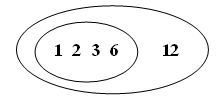Venn Diagrams: 3.75
Supporting materials
Indicator of Progress
Students can correctly describe straightforward relationships between sets of everyday and mathematical objects verbally and can illustrate these with Venn diagrams and two-way tables as appropriate.
From Level 3, students have been able to place individual items correctly in a two-way table or simple Venn diagrams. At Level 3.5 they can focus on the sets and subsets of objects involved, and begin to describe relationships verbally as well as pictorially (Venn diagrams) and in two-way tables. At Level 3.75, they are able to describe more complicated relations between sets. At higher levels, they can use more complicated sets describing them verbally, pictorially and finally using set theory symbols.
Illustrating relationships between sets and attributes with Venn diagrams and two-way tables is an important cross-curricular thinking skill. Clear thinking about set relationships is important for logical thinking in all areas as well as for searching effectively using technology.
Illustration 1: Showing and describing subset relationships
Pose this scenario: any number that divides into one number will also divide into any multiple of that number. This is because factors of the smaller number are also factors of the multiple.
For example, factors of 6 {1, 2, 3, 6} are a subset of the factors of 12 {1, 2, 3, 6, 12}.

At this level, students should be able to illustrate this relationship with a Venn diagram, and describe it verbally as "all factors of 6 are factors of 12" and "some factors of 12 are factors of 6".
Illustration 2: Everyday concepts are generally easier than mathematical concepts
 |
 |
 |
 |
These faces differ in hair colour, eye colour and happiness. A set of faces varying on these attributes can be downloaded here (Word - 36Kb) for classroom activities, or teachers can easily make their own.
Students will find it easier to learn about classification and Venn diagrams by classifying according to everyday concepts such as these, than by classifying according to mathematical concepts.
Similarly, it is generally easier to classify everyday objects than mathematical objects.
Illustration 3: A common error is identifying too many sets as disjoint
Sometimes sets are disjoint. For example the sets of odd and even numbers are disjoint; they have no members in common.
